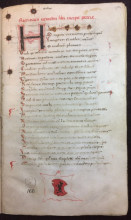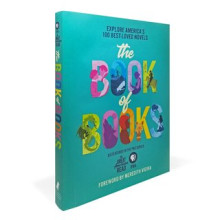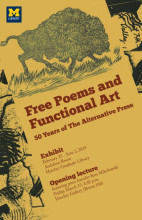Pablo Alvarez
Library Blogs
Showing 1 - 10 of 20 items
Results
for Date: February 2019

When cataloging this fifteenth-century Italian manuscript, I saw that some of the pages have been damaged by brushing a chemical reagent on some areas that were difficult to read. While in the short term this substance was designed to make traces of ink more legible, the long-term impact on the manuscript is disastrous as shown in the image below.

Curious about which university classes are incorporating games into their studies? Here is a list of game-related classes happening this semester.

Are you struggling to find something to read? Do you have a desire to read "great" or "popular" books? If so, check out some of these books that provide rankings and descriptions of "top" books.

Web accessibility is a key ingredient to successful product development that can make or break many peoples’ experience. The U-M Library Digital Accessibility Team (DAT) helps library teams 'bake in' web accessibility from the beginning of their projects and helps coordinate accessibility work across the Library. Read about DAT's services and how collaboration with teams and staff across the library has led to improved products and services for our Library staff, faculty and students.

The Special Collections Research Center is pleased to announce the opening of a new exhibit, Free Poems and Functional Art: 50 Years of The Alternative Press. This exhibit celebrates the 50th anniversary of the founding of The Alternative Press, an experimental small press publisher in Michigan.
•
With a background in physics and criminal justice, and now learning architecture, I’ve been trying to find a way to combine the different areas of my education and, most importantly, how to align them with one of my passions - open and inclusive accessibility. It is easy to connect physics with criminal justice, in the world of forensics, and there are some clear connections between physics and architecture, at least in mechanics. But bringing those two connections together has been challenging. The Raoul Wallenberg Lecture speaker, Eyal Weizman, opened my eyes to possibilities and concepts I had never thought of.
•
Recently, I attended an event known as Inclusion of Individuals with Disabilities: Using Your Skills and Gifts to Create Access in Your Community. It was part of the Center for the Education of Women + Inspire Workshop series. It was such a unique workshop, because workshops gloss over the effects disabilities have on people have them. I personally loved that the speaker, Jacqueline Kaufman, went into detail about disabilities and incorporating deafness with cochlear's. Sometimes, these details are excluded from the conversation. To formally introduce her, she is an Associate Professor of Physical Medicine and Rehabilitation at the University of Michigan Medical school.
I make little sculptures and models in my spare time, so I wanted to try to 3D print something that would be difficult to make by hand. My guiding thought was not ‘Gee, what would be cool to make?’ as much as it was ‘What would a 3D printer be uniquely well-suited to do?’. The Design Lab’s Canvas page recommends looking through sites like Thingiverse where people share different design files in order to get started imagining what to print.
•
This month, I decided to try out a training module on data analysis with Python. While, overall, I think I may have a more conservative outlook on what “Big Data” can help us achieve than some of my peers in the School of Information, there’s no doubt that being conversant with data is becoming increasingly important for a diverse range of fields and tasks. By conversant with data, I mean being able to effectively retrieve, handle, manage, read, describe, understand, repair, process, transform, analyze, and store it, among other things. Being data-fluent is fast becoming an expectation for librarians, and will especially be necessary if I go on to work with research data as a career, as I am currently planning. Additionally, and most germane to the goals of the Shapiro Design Lab, handling and working with volunteer-collected data in varied forms is a key task (and some might say obstacle) of citizen science projects, particularly large scale ones. While a two-hour training module is not going to make anyone an expert on working with data, it’s not a bad place to get an introduction.
•
Have you ever wondered how does google 3D map work? Or, have you ever observed 3D objects in games or movies that look so real, it is impossible for you to believe that it was modeled and rendered artificially?
Well, the answer might be Photogrammetry. Photogrammetry is often defined as the science of taking measurements from photographs. In a simpler term, you can scan an object and create your own 3D model through a free software just by taking a few overlapping pictures of the model. Need fancy cameras? No. You can even use your cellphone camera and take some pictures by hand. Benefit of using photogrammetry over laser scanning is that photogrammetry can provide a vrml file format, that means that it would also include the surface colors of the scanned object. Whereas, laser scanning fails to capture the colors of the surfaces and can only provide an stl file with no color data.
Well, the answer might be Photogrammetry. Photogrammetry is often defined as the science of taking measurements from photographs. In a simpler term, you can scan an object and create your own 3D model through a free software just by taking a few overlapping pictures of the model. Need fancy cameras? No. You can even use your cellphone camera and take some pictures by hand. Benefit of using photogrammetry over laser scanning is that photogrammetry can provide a vrml file format, that means that it would also include the surface colors of the scanned object. Whereas, laser scanning fails to capture the colors of the surfaces and can only provide an stl file with no color data.